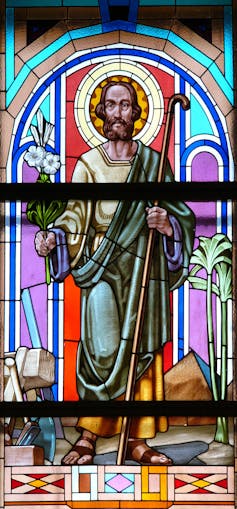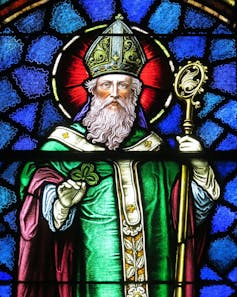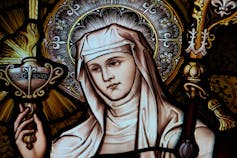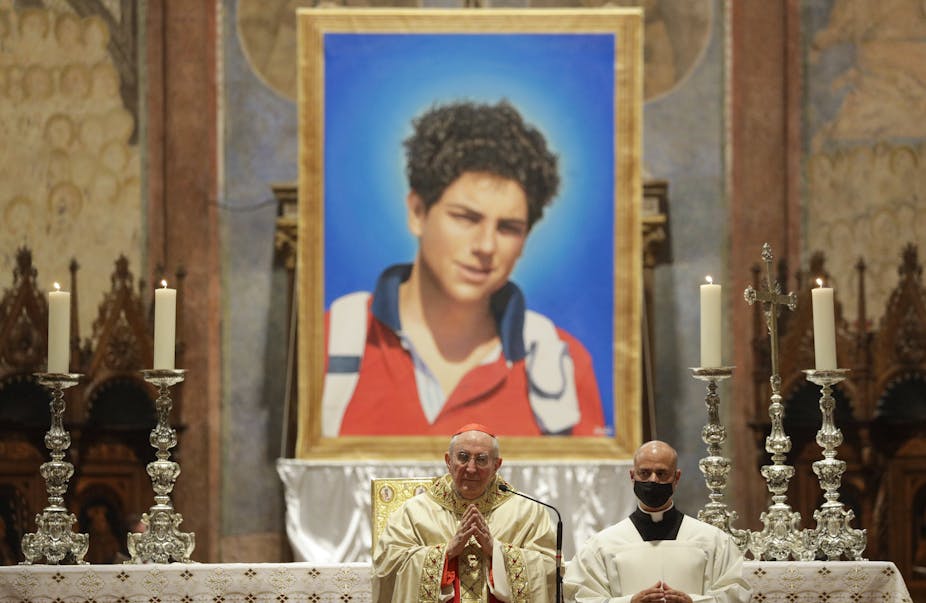On Oct. 10, 2020, Carlo Acutis, a computer enthusiast, was beatified and given the title of “Blessed,” in the town of Assisi in Italy. Already, Catholics are calling this 15-year-old video gamer and computer programmer the “patron saint of the internet.”
Acutis, a devout Roman Catholic, died of leukemia in 2006. After his death, people in his hometown of Milan claimed that miracles took place when they prayed for his assistance with their specific needs.
So what is a “patron saint”?
Spiritual mentors
As a scholar of medieval Christian liturgy and culture, I have studied how saints have been venerated in Western Christianity and their effect on Western culture.
Since the early centuries of Christianity, men and women who died as martyrs for their faith or who lived what were deemed to be exemplary lives in other ways came to be venerated. They were believed to be men and women of “heroic virtue” who after their deaths held a privileged place with God in heaven.
Because of this, saints were considered to be spiritual guides and mentors, who would add their prayers in heaven to those offered by Christians still living in the material world. In this way, they would “intercede” with God on behalf of those who asked for their aid. Devout people would go to their tombs to receive God’s healing grace, and perhaps seek a miraculous cure for their suffering.
During the Middle Ages, the number of saints increased and the popes took charge of approving candidates for sainthood. If their cases withstood scrutiny, these locally venerated holy men and women would be declared official saints. Subsequently, their names would be added to the official list of saints.
Many patron saints
In addition, many saints were venerated for a more specific reason. These saints came to be known as patron saints. Some saints are considered patron saints of nations, cities or other geographical areas. Others were adopted by members of a particular guild or profession.

Take for example St. Florian, a patron saint of both Austria and Poland. A third-century Roman military commander in Central Europe, Florian was martyred for refusing to offer a sacrifice to the Roman state gods.
Today, he is the patron saint of firefighters as well, because of the special military unit he organized specifically to fight fires.
Patron saints are also venerated by those with particular illnesses or concerns. St. Peregrine Laziosi, a 14th-century priest who suffered from cancer himself, is the patron saint of cancer patients.
Some patron saints are invoked in unusual ways. For example, St. Joseph, honored as the spouse of the Virgin Mary and guardian of the child Jesus, was invoked in prayer for centuries by Catholics for assistance in selling a house or property. The custom may date back the 16th century, when the Spanish nun St. Teresa of Avila and her community prayed to St. Joseph for assistance in purchasing a house. They may have chosen St. Joseph because he is the patron saint of fathers, families and carpenters.
Sometimes a holy medal of St. Joseph would be buried in the property. In the United States, it has become popular for homeowners, Catholic or not, to buy a statue of St. Joseph and bury it in the front yard of the house to help it sell more quickly.
Miracles and popular culture
Other saints too have had an influence on popular culture in the United States. For example, the figure of Santa Claus is based on St. Nicholas of Myra.

Nicholas is not only the patron saint of children, but also certain professions. Nicholas was a real bishop active in the fourth century, but the later legend of his life included some dubious miracle stories, including bringing back to life three young students who had been killed by an innkeeper. The man had hidden their dismembered bodies in a barrel, so medieval brewers and barrel-makers claimed him as their patron saint.
Another popular saint in the United States is St. Patrick, a fifth-century Christian missionary to the people of Ireland; he was soon regarded as the patron saint of that country.
For centuries, the Irish observed his feast day on March 17. In the 17th century this was made a universal feast day for all Roman Catholics.
Irish Catholic immigrants brought his feast to the United States, where it is celebrated in many cities through parades, wearing green clothing and drinking green beer. The city of Chicago for decades has dyed the Chicago river green on that day.
Keeping up with modern times

Assignment of patron saints also keeps up with technological advances. In 1958, for example, Pope Pius XII named St. Clare of Assisi, who died in the 13th century, the patron saint of television. On her deathbed, St. Clare is said to have miraculously seen events at Christmas Eve Mass being celebrated some two miles away.
[Deep knowledge, daily. Sign up for The Conversation’s newsletter.]
It is not only the young, 21st-century teenager Carlo Acutis, who loved computers and designed web pages, who is slated to be the patron saint of the internet: St. Isidore of Seville, a seventh-century bishop and scholar who authored a then-comprehensive encyclopedia, is already venerated as such.
But contemporary Catholics should not be surprised that another more contemporary patron saint is being chosen to guide those on the internet to use its knowledge and influence wisely. In the end, this is the role of all patron saints.

